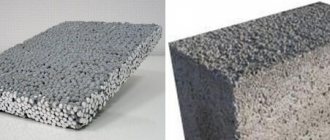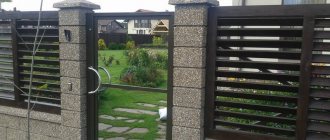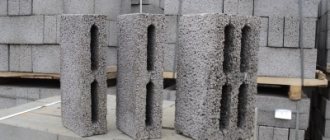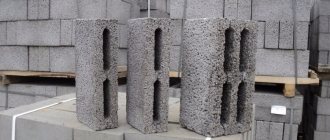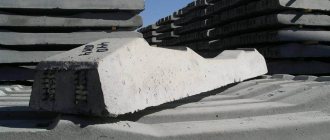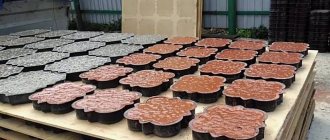Material rating
20 out of 5 price
16 out of 5
service life
16 out of 5
appearance
16 out of 5
ease of manufacture
20 out of 5
labor intensity when using
16 out of 5
environmental friendliness
final grade
4.3
4.3 out of 5
Four decades ago, a material was developed, the formulation of which in our country is regulated by GOST R 51263-99. He points out that when mixing cement, water, some additives for the strength of the solution, as well as polystyrene foam granules, a material is obtained, which is called polystyrene concrete. It has one of the lowest densities - about 150 kg/m3. It is lighter than most building masonry materials. For example, its weight is at least two times less than foam concrete, but, most importantly, in terms of heat conservation, it can easily replace masonry walls with insulation.
Application of polystyrene concrete
A type of lightweight concrete, polystyrene concrete, today successfully competes and sometimes displaces expanded polystyrene, as well as aerated concrete. Possessing good rigidity, heat and sound insulation characteristics, these lightweight blocks can be used for:
- Masonry of external walls of the house.
- Creation of partitions on the upper floors in buildings where, due to the weakness of the floor slabs, it is impossible to use heavier materials, for example, cinder block.
- An additional layer of insulation and sound insulation (this is possible when making polystyrene blocks when pouring formwork).
- Construction of premises where it is necessary to maintain certain temperatures (baths, saunas).
In practice, there is no ban on the use of this material. It fits everywhere. You just need to focus on its thermophysical indicators. So, expanded polystyrene has:
- Density (marked with English D). The minimum indicator is 150, the maximum is 600. Polystyrene concrete is close in this indicator to cinder block. But still inferior to him. Therefore a solid 4.
- Compressive strength from 0.2 MPa to 10 MPa. Strong enough, but no stronger than real concrete. Considering that its service life is more than 10 years, an honest rating of 3.
- Thermal conductivity: minimum 0.05, maximum 0.14 W/m°C. This indicator for polystyrene foam is one of the highest compared to other building materials. Solid 5.
- Frost resistance (marked F). Maximum - from 100 (but then this material will not be so warm), minimum 15. Frost resistance is average. 4 (and it’s a stretch).
- Operating humidity 4 – 8% by weight. Polystyrene concrete repels moisture. But the walls in the steam room must be finished from the inside, because otherwise it will let it through. Rating – 4.
Overall, the average score is 4. Polystyrene concrete is a good building material that is not only easy to use, but also quite simple to manufacture.
Polystyrene concrete blocks in construction:
Advantages and disadvantages
In construction, concrete began to be combined with foam plastic relatively recently. With these working materials in tandem, the wall of any building does not allow atmospheric moisture to pass through and reliably protects the house from the cold. In addition, foam blocks increase the resistance of the structure to aggressive external factors. A significant advantage of combining concrete with foam plastic is the low cost, ease of blocks and installation work.
Among the disadvantages, experienced developers highlight the low strength of the combination of concrete mortar with foam chips.
Concrete mixture with foam has a soft structure, which affects its service life.
To neutralize this disadvantage of the material, you will need to mix the components strictly in the proportions recommended by GOST. There are other disadvantages of a mixture of concrete and foam:
- Soft structure. Due to this, the longevity of the material is shorter than that of concrete blocks, therefore, the total service life of the building screed does not exceed 20 years.
- Toxic fumes. When heated excessively, foam balls release toxic substances that are harmful to the human body.
- Requires finishing. Expanded polystyrene cannot be left in its original form; after attaching it to concrete, it must be plastered.
Production of polystyrene concrete
First, a little about production technology. For the manufacture of any building blocks, polystyrene foam is no exception, it is better to use the pressing method, or even better, vibrocompression of the material. This greatly increases its stability, and hence its service life.
The production of polystyrene foam blocks can be done in two main ways:
- Casting the solution into cassette molds.
- Volumetric vibrocompression of rigid mixtures.
In both cases, the stages of polystyrene concrete production are similar, but there are some technological differences.
Injection molding method
The most common method of producing masonry material is casting into movable, plastic forms. At the filling site, the molds must be lubricated from the inside with a special lubricant. When there is a need to pour the mixture into the formwork, it is installed directly in the place where it is advisable to use polystyrene concrete.
Typically, the cassette method for producing polystyrene blocks involves the use of stable solutions of medium and low density. When producing a large number of blocks, it is advisable to use a foam generator.
This device can continuously supply foam solutions to the concrete mixing tank. You also need to add the required amount of PSV granules there. Finished blocks of medium and low density have a rather low thermal conductivity coefficient.
The disadvantages of the technological process include only 2 facts:
- Good cassettes are expensive.
- It is quite difficult to remove finished blocks from molds, which increases labor costs.
However, with a well-established process for manufacturing a large number of polystyrene blocks, these disadvantages are offset by production volumes.
Vibration pressing
For this method, it is only possible to use polystyrene mixtures with low water content and high cement content. The production of blocks is possible only with the help of vibrocompression equipment.
It happens like this:
- The prepared mixture is fed in portions into the molding machine.
- On the molding trays, which are changed, the process of vibration compaction occurs to a semi-dry state.
- Semi-finished products on pallets are sent to a drying chamber, where they are kept for a certain time.
Finished polystyrene blocks have the stiffest density. The advantages of this technological process:
- The quality of the blocks is the highest.
- There is no need to use cassette forms.
The video will tell and show how the production of polystyrene concrete blocks into molds is carried out:
Varieties
Depending on the purpose, the material is divided into blocks for the main masonry and for creating partitions.
The dimensions of finished polystyrene concrete are as follows:
- 588x300x188 mm, 588x380x300 mm – load-bearing blocks;
- 588x600x92 mm – partition blocks;
- 380x300x1300 mm – blocks for lintels.
Polystyrene concrete lintels PPB-270-III
On request, blocks with less popular dimensions within the range of 195-300 mm width, 288-598 mm length, 88-298 mm height are produced. The weight of the finished product varies from 5 to 30 kg.
Based on density and thermal conductivity coefficient, polystyrene concrete is divided into several grades:
- D600 (600 kg/m³ and 0.145);
- D500 (500 kg/m³ and 0.125);
- D400 (400 kg/m³ and 0.105);
- D300 (300 kg/m³ and 0.085);
- D200 (200 kg/m³ and 0.065);
- D150 (150 kg/m³ and 0.055).
According to another classification, polystyrene concrete grades D450-600 are structural types, grades D350-450 are structural and thermal insulating, and grades D150-350 are thermal insulating. Thermal insulation grades of the material have a strength corresponding to group B2. They are suitable for insulating roofs, attics, and building frames.
Wall panels brand D-500
Structural and thermal insulating polystyrene concrete is suitable for forming lintels in door and window openings and as a filler for external walls. Structural concrete is used to replace conventional materials in load-bearing walls during low-rise buildings.
DIY polystyrene concrete
This building material can be prepared no more complicated than a cinder block. To prepare polystyrene blocks you will need:
- Concrete mixer.
- Crushed polystyrene.
- Cement.
- Sand.
- Water.
You can try to make polystyrene foam with densities D350 and D1200 with your own hands. In this case, the second composition is needed for the preparation of load-bearing structures, and the first is suitable for creating heat-insulating material.
Expanded polystyrene D1200 contains:
- 1.1 m3 of expanded polystyrene crumbs,
- 300 kg of cement,
- 800 kg of sand.
After hardening of the material, a fairly monolithic and strong block of lightweight concrete is obtained.
D350 has the same volume of cement and crumb, but it contains less sand. Ready-made blocks are not suitable for load-bearing structures.
In any case, the stages of preparing polystyrene concrete are as follows:
- Making the mixture. Mix everything thoroughly in a concrete mixer for 20 - 25 minutes.
- Forming the mixture into cassette molds or formwork.
- Drying. In summer, it takes 2–3 days for the finished blocks to be removed from the mold. In winter – a week, or even more.
- If necessary, sawing.
It’s not enough just to crush the foam. It is easily electrified and sticks to objects.
Therefore, if it is not possible to buy this material ready for the production of polystyrene concrete blocks, then you should keep in mind that:
- It’s better to crush it with something quite heavy, and it’s a good idea to place the sheets in a large bag. In this case, you will get heterogeneous crumbs, possibly of a large fraction.
- If you need foam plastic that is small and homogeneous, then you can rub it, for example, on the bottom of a plastic box intended for transporting fruit.
- Self-produced polystyrene concrete blocks may not be as smooth as factory-made ones and their strength percentage will most likely be lower. However, they can be used for the construction of various private housing construction projects. Laying out walls with them is somewhat different from conventional masonry, say, cinder block.
- There are factory-made crushers. The principle of operation is that a layer is supplied to the cutting tool, which is crushed there. Everything is simple and fast, subject to safety regulations. But this device is quite expensive and its purchase is advisable when producing polystyrene blocks in large volumes.
Compound
Portland cement or Portland slag cement is used as a binding component in this building material. Unlike traditional concrete, sand is not used to make the mixture or is introduced in a small volume to increase the strength and rigidity of the blocks.
Important! The main filler is foamed polystyrene in the form of granules with a diameter of no more than 0.5 cm.
Other components may be:
- water;
- tar (to increase hydrophobicity);
- SDO (saponified wood resin) as a microfoaming agent;
- plasticizers;
- Surfactant to improve the adhesion of granules to the bulk;
- curing accelerators, etc.
DIY polystyrene concrete walls
These blocks are large in size and light in weight. Therefore, labor productivity when performing masonry work with them is quite high. It is worth knowing that thin seams are needed for masonry. Their thickness for the outer layer is about 15 mm, and for the inner layer - at least 20. The solution must be made from:
- cement,
- water,
- additives for strength,
- parts of foamed polystyrene.
Considering that the main disadvantage of polystyrene concrete is that it is not very durable (the process of destruction begins 20 years after its manufacture), the masonry of walls must necessarily include external treatment of the seams with the same mortar that held the blocks together. The thickness of the walls is usually one block, since this material is very warm.
Adhesive for laying polystyrene concrete blocks
Craftsmen recommend adding special glue to the masonry solution. But it’s still better to either put it on cement mortar or glue, that is, do not mix these materials. The use of glue allows you to minimize the “cold bridges” that are masonry joints, and thereby reduce its consumption.
Typically, glue has low thermal conductivity (it varies, and the price depends on it, so you need to choose the glue based on this characteristic and taking into account the climatic zone of your residence). It is also worth considering that glue is ideal for the construction of low-rise buildings.
More clearly about how to lay polystyrene concrete blocks on glue:
Features of building a house made of polystyrene concrete
Polystyrene concrete is a remarkably warm and lightweight material, but you need to know that its cladding must take into account its features, including thermal conductivity. This means that plastering must be done with a solution that will have a vapor permeability higher than polystyrene concrete. Otherwise, after a couple of years the plaster will begin to peel off.
Naturally, it is necessary to perform reinforcement. For polystyrene concrete blocks, it is better to reinforce every third row. It is worth knowing that this material has no more than 20 cycles of frost resistance, so if you want to build a family nest from it, in which great-grandchildren could then live, it is better to look for another more durable material.
Below are the realized projects of houses made of polystyrene concrete blocks:
house number 1
house number 2
house number 3
house number 4
Polystyrene concrete for baths
These blocks with polystyrene foam in their composition can well serve as the outer walls of a bathhouse. For internal ones, especially for steam zones, it is better not to use them, since polystyrene concrete allows gas and steam to pass through it. And this is not entirely environmentally friendly for places with high humidity. For a bathhouse made of polystyrene concrete in a temperate climate zone, you can do without external insulation.
Comparative analysis of products
When choosing a material suitable for building walls, any developer will decide to compare different product options, which is not surprising. Each of them has an advantage, to one degree or another. Let's figure out how polystyrene concrete is superior to its main competitors in the construction industry.
Table 2: Comparison of polystyrene concrete and similar wall materials.
| Property name | Polystyrene concrete | Brick | Expanded clay concrete | Aerated concrete | Tree | Foam concrete |
| Thermal conductivity | 0,1-0,145 | 0,5 | 0,4-0,8 | 0,10-0,14 | 0,14 | 0,14-0,25 |
| Frost resistance | 70-150 | 100 | From 50 | 25-100 | From 70 | From 35 |
| Density | 150-600 | 1400-1700 | 850-1800 | 400-1200 | 500-700 | 600-1000 |
| Strength kg/m3 | 15-35 | 100-200 | 35-75 | 25-45 | 380-450 | 15-25 |
| Comparative wall thickness | From 0.4 | From 1.2 | From 1 | From 0.4 | From 0.5 | From 0.6 |
| Water absorption | Up to 4% | 12-18% | 8-14% | 25% | 25-30% | 10-15% |
As can be seen from the table, polystyrene concrete is characterized by a relatively good thermal conductivity coefficient. At the same time, the number of freezing and thawing cycles that this material can withstand exceeds all similar products by a large margin.
The ability to absorb moisture is quite acceptable; a figure of 4% is not such a bad result. It is also worth noting that the numerical value of shrinkage of polystyrene concrete is 1 mm/m2. This is significantly more than that of aerated concrete, but less than that of wood.
In general, the material, like all others, wins in some indicators and inferior in others. And until the perfect material is created, developers will have to select suitable products, while prioritizing the most important qualities in each individual case individually.
Comparison of thermal efficiency of materials
External differences in the structure of various wall materials
Installation of polystyrene concrete screed
Scope of work:
- Surface preparation. The installation of floors is carried out after the complete completion of all construction, sanitary, electrical and finishing works.
- the base is leveled by cutting down all protrusions, sealing depressions, cracks and cracks with cement mortar grade ≥ M100, checking horizontality using a laser level;
- garbage collection;
- dust removal of the base.
- covering the walls around the entire perimeter and existing columns with damper tape to the height of the screed;
- installation of beacons made of wooden blocks, plastic or metal profiles. You can use screws screwed into the ceiling with plastic dowels.
- Prepare the solution in small portions.
- The technology of polystyrene concrete screeds is practically no different from the construction of conventional cement-sand screeds. Execution sequence:
- moistening the surface with cement laitance or plain water; the formation of puddles is unacceptable;
- the layout of the mixture is slightly higher than the beacons. The recommended layer of screed is 4...5 cm. There should be no drafts in the room that would prevent the solution from drying well without cracking;
- distribution of the mixture using a rule or a wide spatula with alignment along the beacons. To compact, you can use a light slamming rule. Work begins from the far corners, moving towards the entrance door to the room. Simultaneously with smoothing the solution, the screed is covered with plastic film, for which, after laying in small sections, the roll with the film is rolled out towards itself;
- after 24 hours, the beacons are dismantled and the resulting recesses are sealed with polystyrene concrete mortar; the use of cement-sand mixtures is unacceptable;
- to strengthen the coating, you can perform reinforcement with steel mesh, laying it at a distance from the ceiling at 1/3 of the height of the screed;
- with room area ≥ 30 square meters. m, expansion joints are installed; if smaller, the joint is placed near the door thresholds. Seams with a depth of 2/3 of the screed thickness and a thickness of ≥ 3 mm can be made directly during pouring.
- The screed covered with plastic film is left to gain strength for 5 days. To remove excess moisture from the coating, it is left to dry without covering for two to three weeks, depending on the thickness of the screed.
- If necessary, final leveling of the surface is carried out with cement mortar, followed by grinding with grinders. Self-leveling mixtures can be used.
Installing a polystyrene concrete floor with your own hands, made in compliance with the correct proportions when preparing the solution and strict adherence to the recommendations, guarantees the construction of a strong and durable rough floor covering without the involvement of expensive craftsmen.
Exterior finishing
How to calculate the required number of blocks for construction
Calculating the amount of material is quite simple.
Let's look at it step by step:
- Let's assume that a block measuring 598*298*200 will be used when laying a building measuring 12*15 meters.
- We calculate the perimeter of the building: 12*2+15*2=54
- We calculate the area of the building, with a wall height of 3 meters: 54*3=162 m2
- We subtract the area of window and door openings, assuming that it is equal to 20 m2: 162-20 = 142 m2
- Next, we are interested in the area of the block itself: 0.598*0.298=0.178204 m2
- Let's find out the required quantity in pieces: 142/0.178204=796.83, and taking into account rounding - 797 pieces.
- Now you need to calculate how many polystyrene concrete blocks are in a cube. To do this, we find out the volume of one block: 0.598*0.298*0.2=0.0356408. 1/0.0356408=28.05 m3. 796.83/28.05=28.40. Taking into account rounding, we will need 29 m3 of block.
Negative characteristics of polystyrene foam
According to its parameters, polystyrene foam is not very suitable for wood, since it does not breathe, while wood has such a need. This material cannot be used for installing roofs with wooden rafter systems. The surface of the blocks can be destroyed by exposure to the sun and high temperature. However, if we are talking about walls, then the base of PPS slabs can be covered with a layer of plaster, which is applied to a special steel mesh; in some cases, the traditional painting method is used.
Pros of expanded polystyrene
- high rigidity;
- ability to endure heavy loads;
- good thermal performance;
- not saturated with moisture;
- frost resistance;
- long service life.
Cons of expanded polystyrene
- destroyed by exposure to the sun;
- not recommended for use in internal insulation;
- cannot be mounted on wooden walls.

